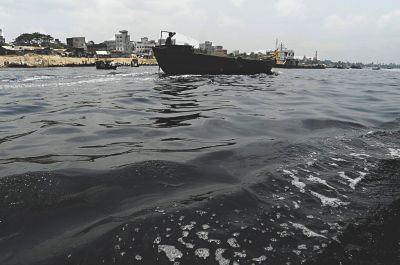A survey conducted on Tuesday at different spots on the Buriganga River — from Sadarghat to Pagla — showed inadequate presence of dissolved oxygen (DO) in the water to support the existence of fish and other living organisms.
The survey conducted by a group of experts under Poribesh Bachao Andolon (Poba) collected water samples from different spots between Sadarghat and Pagla areas also revealed that the presence of intoxicants in its water is higher than the level suitable for living organisms.
The DO levels are much lower than the permissible limit mentioned in the Environment Conservation Act 1997, while the presence of intoxicants is much higher than the permissible limit of the Act.
According to Environment Conservation Act 1997, the permissible level of DO in water must be higher than 5 milligram per litre and the permissible limit of intoxicants must be around pH 7.
After the examination of the water samples, it was found out that the DO levels were between 0.21 milligram per litere and 0.55 milligram per litre.
The lesser concentrations of DO were recorded near the dockyard on the southern bank of the Buriganga.
The water intoxicant or the pH level of the examined water stood between pH 7.9 and pH 10.32, the higher intoxicant levels were recorded near dyeing factories along the bank.
The government also estimates that about 21,000 cubic meters of untreated industrial sewage is released into Buriganga waters every day.
In a report published in October, 2012, Human Rights Watch, an international rights watchdog, observed that residents in neighbouring slums regularly suffer from fevers, skin diseases, respiratory problems, and diarrhea.
Source: UNBConnect












